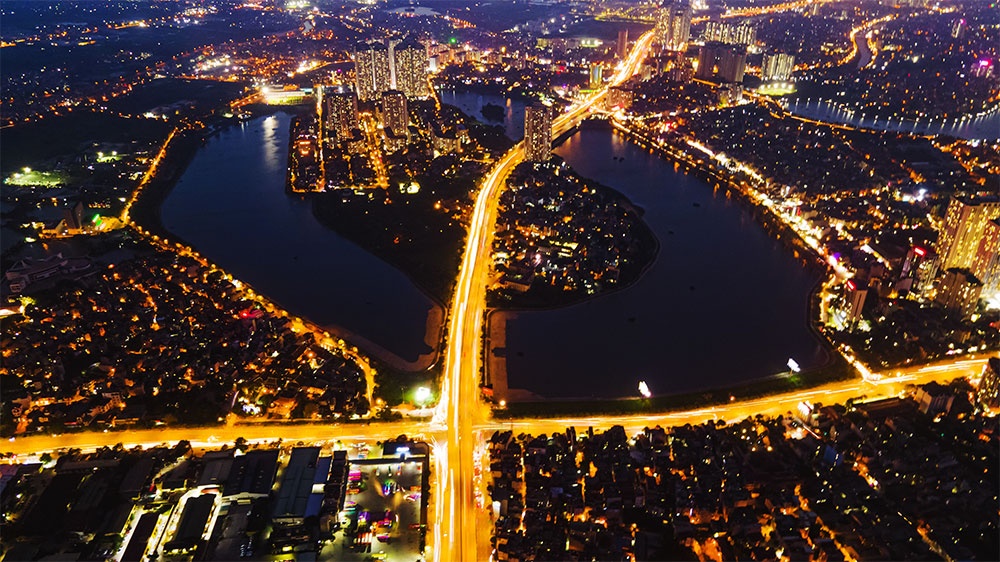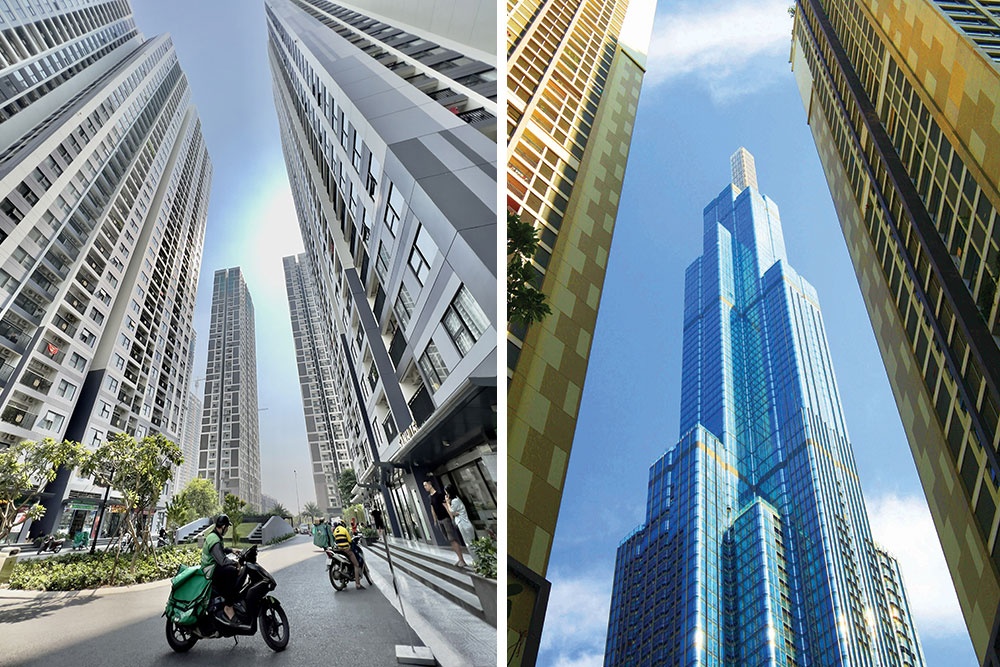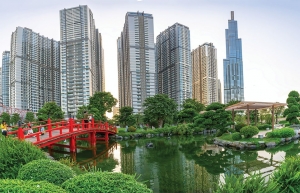Tackling the challenges in megacity development
By 2030, Ho Chi Minh City is expected to become Vietnam’s first megacity with a population reaching 10.2 million, making it the fourth most populated city in Southeast Asia behind Manila, Jakarta, and Bangkok. On the same trajectory, Hanoi is headed towards becoming a megacity soon after.
Megacities are growing at an unprecedented rate. To reach the population size that New York did in 150 years, Mexico City and São Paulo only took 15 years. While the emergence of megacities might signal the rapid development of a country’s economy, the increased concentration of population at such a large scale also comes with significant environmental, socioeconomic, and infrastructure challenges.
Tackling these challenges of megacities will be critical to ensure citizens’ fair access to resources and services, maintain social stability, uphold continuous economic development, while mitigate and adapt to climate change.
 |
| Tackling the challenges in megacity development |
Varying challenges
Some of the most typical environmental issues large cities face are waste, air pollution, and climate change caused by a high level of socioeconomic activities and insufficient environmental actions led by the government. In Vietnam, air pollution tops environmental concerns among the country’s citizens, followed by water pollution, food contamination, plastic waste pollution, deforestation, and global warming.
Air quality in Ho Chi Minh City and Hanoi have been at constantly worrying levels in recent years. This is commonly observed in other big megacities such as Beijing and Seoul.
Megacities also face major challenges in providing adequate economic and social opportunities for their massive and growing population. One of the biggest problems among these is unemployment. Around 20-25 per cent of urban adults in the least developed countries do not have regular work, according to the International Labour Organization.
Employment difficulties, together with increased inequality, tight living spaces, poor living conditions, lack of access to education, and so on, are among the factors that stimulate urban crime and hamper social stability.
In addition, urban areas aim at serving their population with foundational infrastructures such as housing, traffic infrastructure, telecommunications networks, education and healthcare institutions, commercial areas, recreational and green spaces, and so on. Without this, socioeconomic development and stability are at risk of being stifled.
The swelling population of megacities is creating mounting pressure on their infrastructure systems. Traffic congestion, slum and squatter settlements, hospital overload, flooding, and lack of green spaces are among the prevalent infrastructure-related issues that many megacities, especially those in developing countries, are faced with.
 |
| Il-Dong Kwon - Managing director and partner Boston Consulting Group Vietnam and Arnaud Ginolin - Partner Boston Consulting Group Vietnam |
Environmental protection
Cities around the world are enforcing changes by passing progressive environmental regulations to restrict traffic emissions, reduce plastics consumption, increase energy efficiency, promote renewable energy, and mitigate the effects of climate change.
For example, aiming to reduce greenhouse gases by 40 per cent and vehicle operation by 30 per cent by 2030, the Seoul metropolitan government has designated a 16.7-square kilometre Green Transportation Zone area in Seoul’s city centre for the development and promotion of green transportation.
Since the zone’s full-scale operation, the volume of Grade 5 vehicles has decreased by 46 per cent, the number of public bike rentals increased by 67 per cent, and particular matter levels in the air reduced by 2 tonnes per year.
In July 2022, Mumbai introduced a new plastic ban, in which 21 selected disposable plastic items were prohibited for their low utility and high littering potential. These include single-use cutlery, plastic sticks for ice cream, candies, balloons, various decorations, and plastic flags.
This ban was issued on top of a more extensive ban on all types of single-use plastic carry bags effective since 2018. Compared to the pre-2018 scenario, the waste of single-use plastic and carry bags has shrunken by 50-60 per cent.
As a city with 40 per cent of its area – home to 10.5 million people – currently below sea level, Jakarta is the world’s fastest sinking city. As it has only a decade to halt its sinking, the city is taking urgent and bold climate action to solve the immediate issue of flooding and improve its relationship with the environment. On the adaptation track, Jakarta has been putting effort into improving its drainage system and removing plastic waste and sewage from its 13 rivers.
Ongoing adaptation initiatives and new infrastructure investment have witnessed a decrease in flooding by 28 per cent. On the mitigation track, the city is pushing for energy efficiency in commercial buildings and industry, public transport and cycling infrastructure expansion, waste management transformation, and urban parks development.
 |
Tackling unemployment
As a key driver of the social income gap, governments around the world are pulling several levers to generate new employment through stimulating economic development and improve the efficiency of the current labour market. This is usually done at both city and country levels, as the solution requires high-level fiscal and monetary levers to stimulate demand.
Singapore’s unemployment rate is among the lowest among nations in the Organisation for Economic Co-operation and Development, fluctuating around 2.2 per cent between 2012 and 2021. Going through the COVID-19 pandemic, unemployment rates in 2020 and 2021 were at 3 per cent and 2.7 per cent respectively.
The low level of unemployment was attributed to the country’s strong economy with leading foreign investment inflows, as well as the government’s success in implementing various programmes to encourage the hiring of locals, reduce job losses, and support workers in upskilling and job searching amid economic uncertainty.
For example, the SGUnited Jobs and Skills Package was introduced in 2020 to facilitate the matching of jobseekers and full-time job and traineeship opportunities, as well as provide certifiable courses to upskill or reskill workers in high-demand sectors. Nine months after its introduction, 76,000 people have found placements through the scheme.
Another example is the Job Support Scheme, which provided wage support for employers to retain their local employees during the pandemic. It was estimated that the scheme saved 165,000 local jobs between March and December 2020.
Boston Consulting Group has also been a contributor to this effort by providing support to the development and implementation of the RISE programme, aiming at reskilling and upskilling experienced workers towards digital jobs.
In Malaysia, to mitigate socioeconomic problems arising from the sudden loss of income due to job losses, the government provides transitional income support to unemployed workers in the private sector. Its employment insurance system provides five types of benefits: job search, early re-employment, reduced income, training allowance, and training fee.
Besides financial support, the government also set up a one-stop digital platform for all employment services, including job posting and application, promotion of labour market programmes, and personalised career counselling services. Data about the labour market collected through this platform is then used to enable better policymaking.
Solving infrastructure barriers
While the challenge with megacity infrastructure development consists of various fragmented moving pieces, these pieces must always be put side by side in an integrated big picture. Solving infrastructure challenges requires holistic and long-term planning, great and well-distributed capital, and strong implementation capability.
A classic case in point of a city going from urban squalor and crumbling buildings to one of the most liveable cities in the world within less than 60 years is Singapore. Among many factors, far-sighted planning that considers a comprehensive view of the city’s future infrastructure needs and sustainable development are among the critical elements behind its success.
Singapore developed its first city concept plan in 1971, which played the role of a development framework that would serve the country’s socioeconomic needs in the long term. The plan was initially developed by government agencies, then in its later version solicited views from the private sector and academia.
This consultative approach was intended to tap the ideas, skills, and experience of the private sector and ensure that the land use plan in each zone took into account the opinions and ideas of all interested sectors of Singapore society.
Since the early days, Singapore has closely tied residential and commercial developments with transport planning. Environmental protection goals and green areas planning were also integrated into the country’s earliest urban planning since the 1960s.
Another notable element is the city’s strong focus on providing affordable public housing and increasing home ownership as an important institutional pillar in the country’s nation-building project.
Overall, to tackle increasingly impactful environmental, socioeconomic, and infrastructure challenges, megacities first need to set bold, yet realistic ambitions across major dimensions to retain and attract citizens. With these ambitions, the city will then design a holistic city plan setting the long-term vision and strategies across all development pillars, with a clear execution plan and required enablers.
Good city planning should integrate inputs from various public and private sector bodies and experts, embracing a citizen-centric methodology, while aligning well with the central government’s directions. Finally, an efficient city governance structure will be a critical enabling factor for megacities’ harmonious development.
 | Outlining Vietnam's urban identity The process of urbanisation and urban development is posing numerous challenges in balancing development goals and preserving urban identity, as well as ensuring quality of life. Dr. Ngo Viet Nam Son, chairman of NgoViet Architects & Planners, talked with Trong Tin about the thorny issues. |
What the stars mean:
★ Poor ★ ★ Promising ★★★ Good ★★★★ Very good ★★★★★ Exceptional
Related Contents
Latest News
More News
- Green finance offers 'passport' for Vietnamese construction, building materials firms (December 15, 2025 | 08:00)
- Gamuda Land commit long-term investment (December 12, 2025 | 11:49)
- HITC ties up with Evolution to develop AI and hyperscale data centres in Vietnam (December 11, 2025 | 12:09)
- Real estate deals boom via high-profile names (December 08, 2025 | 11:32)
- Industrial segment shaped by M&As (December 08, 2025 | 08:00)
- The Privé sets the benchmark for luxury real estate (December 05, 2025 | 08:28)
- TD CASA and the rise of bespoke interior design in luxury living spaces (December 03, 2025 | 14:14)
- Lee Soo-man's Blooming Sky to build Gia Lai culture, sport, and entertainment complex (December 02, 2025 | 16:41)
- Sustainability in DNA of Keppel Vietnam's future urban development strategy (November 28, 2025 | 10:53)
- South Korean investors seek clarity on IP lease extensions (November 24, 2025 | 17:48)

 Tag:
Tag:





















 Mobile Version
Mobile Version